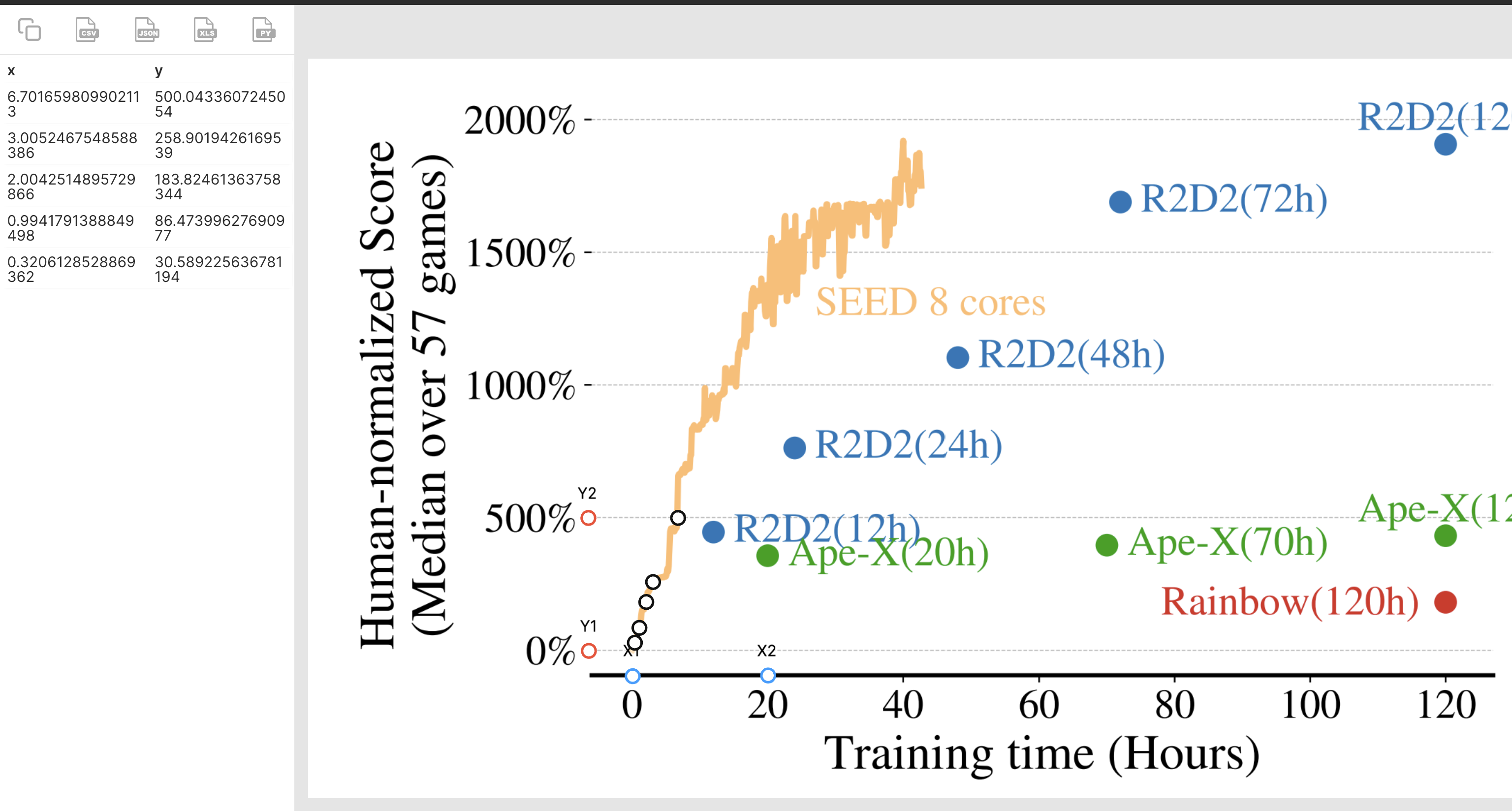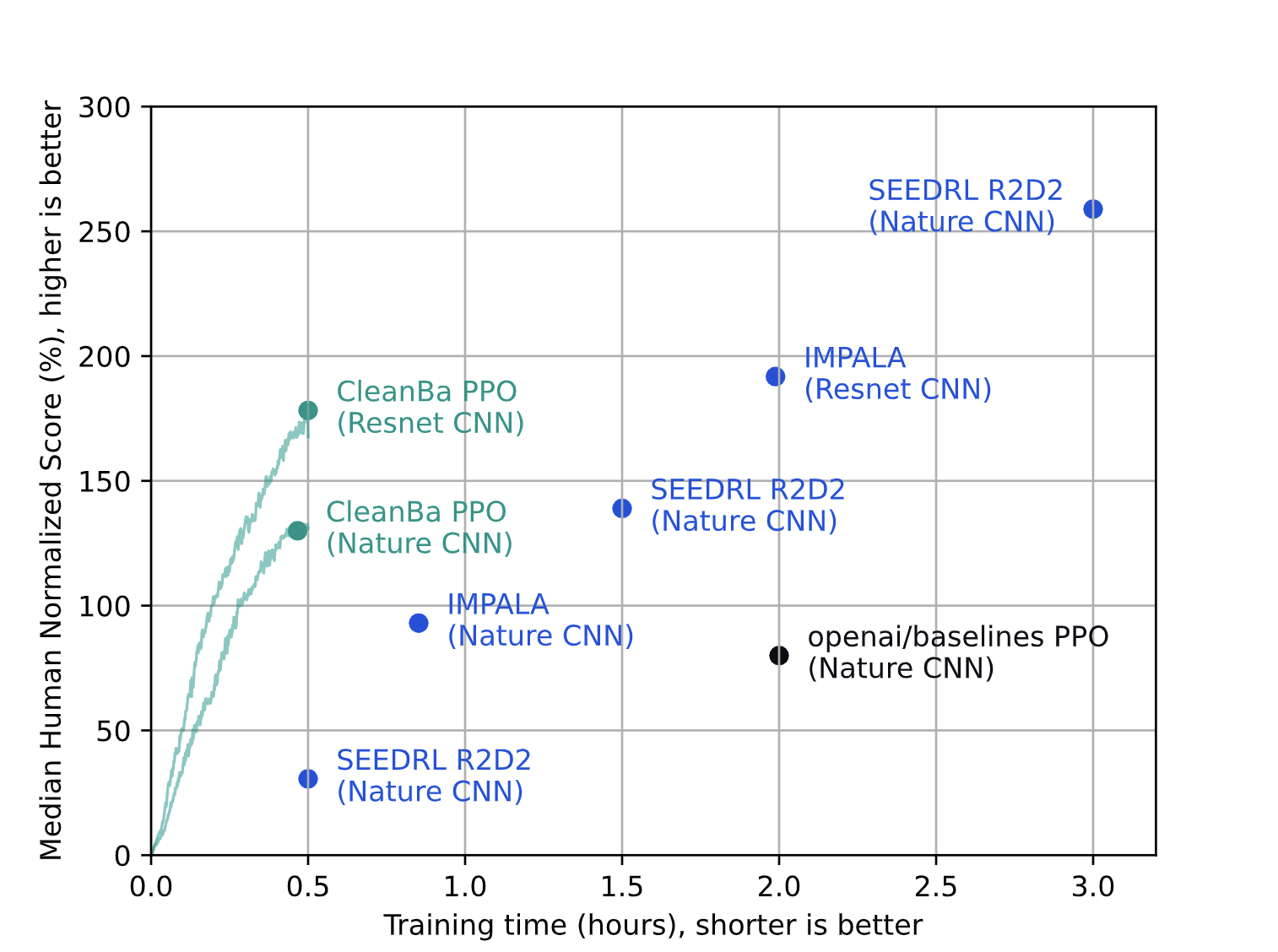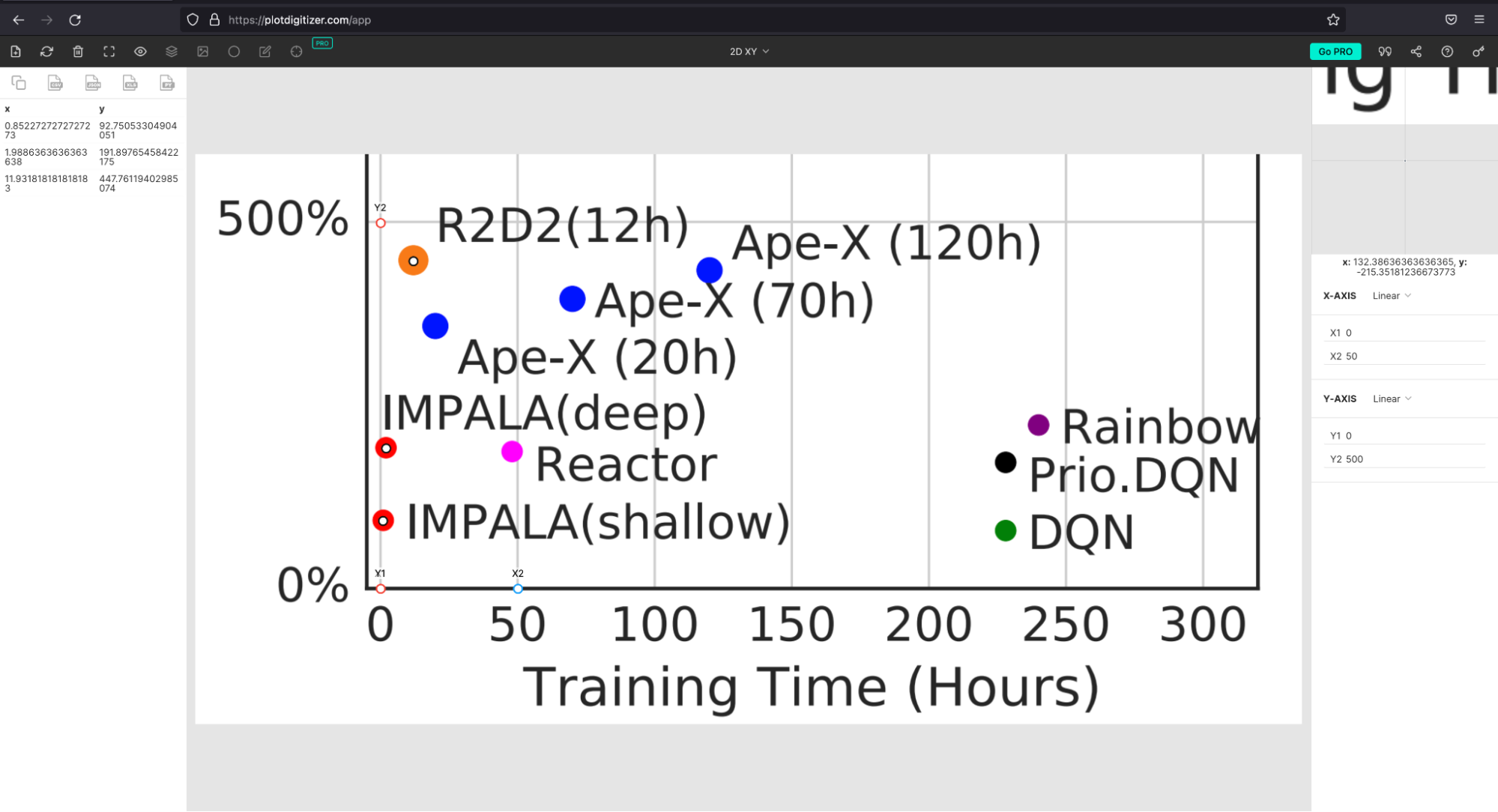Cleanba is CleanRL's implementation of DeepMind's Sebulba distributed training framework, but with a few different design choices to make distributed RL more reproducible and transparent to use.
Warning This repo is a WIP made public because it's easier for me to share pointers with collaborators. We are still working on the documentation, the codebase, and some internal development. Please feel free to open an issue if you have any questions or suggestions.
Warning This repo is intended for archiving purposes. Once the codebase is stable, we will move it to CleanRL for future maintenance.
Highly reproducible: More GPUs only make things faster. You can always reproduce the same results with a single GPU.
High-performing: We can currently achieve 178.24% median human-normalized score across 57 Atari games in ~30 mins, with 8 GPUs (distributed 2 times on 4 GPUs). This is a 4x walltime speedup compared to the IMPALA (Espeholt et al., 2018) paper, and a 1.5x speedup compared to the original Sebulba (Hessel et al., 2021) paper.
Scalable: We can scale to N+ GPUs allowed by jax.distributed and memory (e.g., it can run with 16 GPUs). This makes cleanba suited for large-scale distributed training tasks such as RLHF.
Understandable: We adopt the single-file implementation philosophy used in CleanRL, making our core codebase succinct and easy to understand. For example, our cleanba/cleanba_ppo_envpool_impala_atari_wrapper.py is ~800 lines of code.
Prerequisites:
- Python >=3.8
- Poetry 1.3.2+
poetry install
poetry run pip install --upgrade "jax[cuda]==0.3.25" -f https://storage.googleapis.com/jax-releases/jax_cuda_releases.html
poetry run python cleanba/cleanba_ppo_envpool_impala_atari_wrapper.py
poetry run python cleanba/cleanba_ppo_envpool_impala_atari_wrapper.py --help
Let us use a0-l1,2,3-d1 to denote our setups, where a0 means actor on GPU 0, l1,2,3 means learner on GPUs 1,2,3, and d1 means the computation is distributed 1 time.
Here are come common setups:
# a0-l0-d1: single GPU
python cleanba/cleanba_ppo_envpool_impala_atari_wrapper.py --actor-device-ids 0 --learner-device-ids 0 --track
# a0-l0,1-d1: two GPUs
python cleanba/cleanba_ppo_envpool_impala_atari_wrapper.py --actor-device-ids 0 --learner-device-ids 0 1 --track
# a0-l1,2-d1: three GPUs
python cleanba/cleanba_ppo_envpool_impala_atari_wrapper.py --actor-device-ids 0 --learner-device-ids 1 2 --track
# a0-l1,2,3-d1: four GPUs
python cleanba/cleanba_ppo_envpool_impala_atari_wrapper.py --actor-device-ids 0 --learner-device-ids 1 2 3 --track
# a0-l1,2,3,4-d1: five GPUs
python cleanba/cleanba_ppo_envpool_impala_atari_wrapper.py --actor-device-ids 0 --learner-device-ids 1 2 3 4 --track
# a0-l1,2,3,4,5,6-d1: seven GPUs
python cleanba/cleanba_ppo_envpool_impala_atari_wrapper.py --actor-device-ids 0 --learner-device-ids 1 2 3 4 5 6 --track
# a0-l0-d2: 8 GPUs (distributed 2 times on 4 GPUs)
# execute them in separate terminals; here we assume all 8 GPUs are on the same machine
# however it is possible to scale to hundreds of GPUs allowed by `jax.distributed`
CUDA_VISIBLE_DEVICES="0,1,2,3" SLURM_JOB_ID=26017 SLURM_STEP_NODELIST=localhost SLURM_NTASKS=2 SLURM_PROCID=0 SLURM_LOCALID=0 SLURM_STEP_NUM_NODES=2 python cleanba/cleanba_ppo_envpool_impala_atari_wrapper.py --distributed --actor-device-ids 0 --learner-device-ids 1 2 3
CUDA_VISIBLE_DEVICES="4,5,6,7" SLURM_JOB_ID=26017 SLURM_STEP_NODELIST=localhost SLURM_NTASKS=2 SLURM_PROCID=1 SLURM_LOCALID=0 SLURM_STEP_NUM_NODES=2 python cleanba/cleanba_ppo_envpool_impala_atari_wrapper.py --distributed --actor-device-ids 0 --learner-device-ids 1 2 3
# if you have slurm it's possible to run the following
python -m cleanrl_utils.benchmark \
--env-ids Breakout-v5 \
--command "poetry run python cleanrl/cleanba_ppo_envpool_impala_atari_wrapper_large.py --distributed --learner-device-ids 1 2 3 --track --save-model --upload-model" \
--num-seeds 1 \
--workers 1 \
--slurm-gpus-per-task 4 \
--slurm-ntasks 2 \
--slurm-nodes 1 \
--slurm-template-path cleanba.slurm_template
Cleanba addresses the reproducibility issue by making ensuring the actor's policy version is always exactly one step behind the learner's policy version. The idea is similar to HTS-RL, but the executions are completely different.
Here is a pseudo-code of Cleanba's core idea:
rollout_queue = Queue.queue(len=1)
param_queue = Queue.queue(len=1)
def actor():
for iteration in range(1, num_iterations):
if iteration != 2:
params = param_queue.get()
data = rollout(params)
rollout_queue.put(data)
def learner():
for iteration in range(1, num_iterations):
data = rollout_queue.get()
agent.learn(data)
param_queue.put(agent.param)
agent = Agent()
param_queue.put(agent.param)
threading.thread(actor).start()
threading.thread(learner).start()Notice that the iteration != 2 ensures actor is exactly 1 policy behind learner's latest policy.
Let us use pi to denote policy of version i, di the rollout data of version i. Then we have
iteration: 1 2 3
actor: p1->d1 p1->d2 p2->d3
learner: d1->p2 d2->p3
In the second iteration, we skipped the param_queue.get() call, so p1->d2 happens concurrently with d1->p2. Because get() and put() operations are blocking and we have the queue sizes to be 1, we made sure actor's policy version is exactly 1 version preceding the learner's policy version.
To improve efficiency of Cleanba, we uses JAX and EnvPool, both of which are designed to be efficient. To improve scalability, we allow using multiple learner devices via pmap and use jax.distibuted to distribute to N-machines.
Espeholt et al., 2018 did not disclose the hardware usage and runtime for the Atari experiments. We did our best to recover its runtime by interpolating the results from the R2D2 paper and found IMPALA (deep) takes ~2 hours.
SEED RL's R2D2's performance is extracted from its paper:

We thank Stability AI's HPC for generously providing the computational resources for this project.



